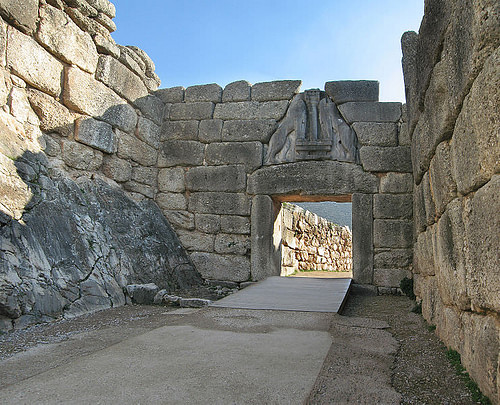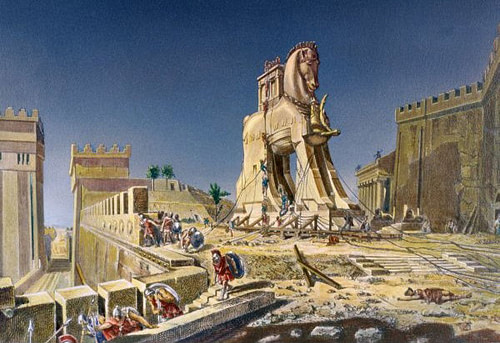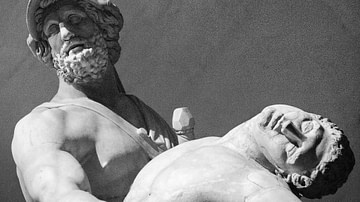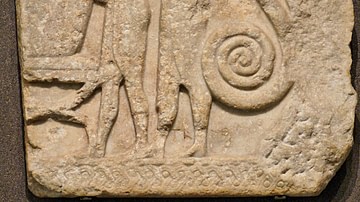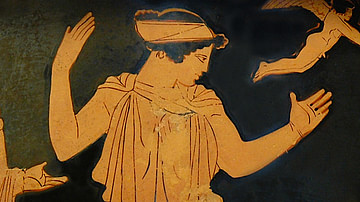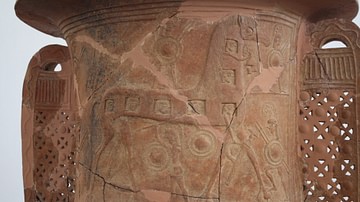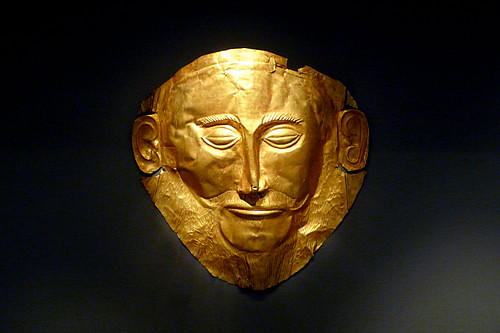
Agamemnon was the legendary king of Mycenae and leader of the Greek army in the Trojan War of Homer's Illiad. Agamemnon is a great warrior but also a selfish ruler who famously upset his invincible champion Achilles, a feud that prolonged the war and suffering of his men.
Agamemnon is a hero from Greek mythology but there are no historical records of a Mycenaean king of that name. The Greek city was a prosperous one in the Bronze Age, and there perhaps was a real, albeit much shorter, Greek-led attack on Troy. Both these propositions are supported by archaeological evidence. Unfortunately, though, the famous gold mask found in a shaft grave at Mycenae and widely known as the 'Mask of Agamemnon' is dated up to 400 years before any possible Agamemnon candidate that fits a chronology of the Trojan War.
Agamemnon's Family
Agamemnon was the son of Atreus, or perhaps grandson, in which case his father was Pleisthenes. His mother was Aerope, from Crete which provided a handy link between the Mycenaean civilization of the Greek Peloponnese and the earlier Minoan civilization of Bronze Age Crete. He was married to Clytemnestra with whom he had three daughters. In one version these are Chrysothemis, Laodice and Iphianassa while in other, later versions they are Chrysothemis, Electra and Iphigeneia. Agamemnon was the brother of Menelaos, king of Sparta.
King of Mycenae
According to Homer, Agamemnon was given his king's sceptre and right to rule Mycenae and all the Achaean Greeks by Zeus himself. Agamemnon is described as a great warrior and so is a worthy leader of men. According to Plato, his name derives from menein meaning 'to endure'. Mycenae, located 15 km from the sea in the northern Peloponnese, then prospered and Homer describes the city as a 'well-founded citadel', as 'wide-wayed' and as 'golden Mycenae'. This mythological prosperity is supported by the excavation of over 15 kilograms of gold objects recovered from the shaft graves in the fortified acropolis which still dominates the plain today. Further excavations have also revealed that the city once covered 30,000 square metres and was first inhabited in Neolithic times.
The Trojan War – The Beginning
Our main source of information on the Trojan War is Homer's epic mythological account in the Iliad, written in the 8th century BCE but almost certainly based on a much older oral tradition. The ancient Greeks themselves considered the conflict to have been a real one and taken place in the 13th century BCE. The story came to represent the struggle of Greeks against foreign powers, and it told tales of a time when men were better, more able, and more honourable. After Homer, the Trojan War became a staple theme in Classical Greek and Roman literature and was revisited many times by writers in works such as Aeschylus' Agamemnon, Euripides' Trojan Women, and Virgil's Aeneid. Later authors, especially Aeschylus, altered parts of the story, probably for dramatic effect on an audience all too familiar with it. Scenes from the conflict were also a favourite with visual artists for the next millennium.
The war began when Paris, a Trojan prince, abducted Helen, wife of Menelaus, from Sparta. Paris regarded her as his rightful reward for choosing Aphrodite as the most beautiful goddess in a competition with Athena and Hera at the wedding of Peleus and Thetis. A furious Menelaus then appealed to his brother Agamemnon to create a coalition force of Greek warriors and rescue Helen from Troy. This Agamemnon did, and the force from such cities as Athens, Sparta, Corinth, Rhodes and just about everywhere else across Greece sailed in a huge fleet across the 'wine-dark sea' to Anatolia.
Well, they would have done if Agamemnon had not upset the goddess Artemis when he killed one of her sacred stags and then boasted he was a better hunter than the goddess, herself famous for her hunting skills. As punishment, Artemis becalmed the Greek fleet and only the sacrifice of Iphigeneia would appease the goddess into granting a fair wind to Troy. Agamemnon duly offered his daughter in sacrifice, but in pity and at the last moment, the goddess substituted a deer for the girl and made Iphigeneia a priestess at her sanctuary at Tauris. In Aeschylus' version, Agamemnon ruthlessly sacrifices his daughter, then still a child, and so guarantees his wife's eternal hatred and his own murder later on in the story.
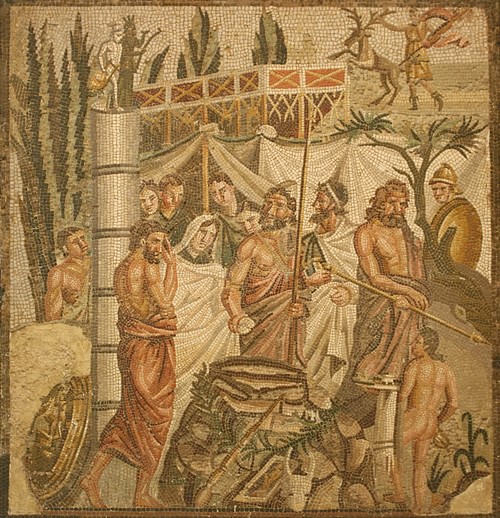
Agamemnon Upsets Achilles
Finally arriving at Troy, most of the next nine years was spent in the Greeks laying siege to the well-fortified city. Indecisive skirmishes ensued but, as the Iliad tells, the time was near for the decisive moments of the war. As Agamemnon roused his men thus,
Let every man of you prepare well for the fighting – put a good edge on your spears, and a good hang to your shields, give a good feed to your swift-footed horses, and cast a good eye over your chariots, so that we can run the trial of hateful Ares all day long. (Iliad, Book 2, 380-384)
However, after another inconclusive clash things finally got more interesting with a couple of one-on-one battles, first between Menelaus and Paris, and then Ajax against Paris' brother Hector. Neither dual ended in a fatality. More skirmishes followed and in these Agamemnon excelled:
As when annihilating fire falls on a thick forest scrub, and the wind carries it billowing all over, and the bushes are brought down headlong in the flames' overwhelming onslaught, so the fleeing Trojans went down under Agamemnon, son of Atreus, and many strong-necked horses rattled empty chariots along the avenues of battle, missing the noble charioteers they knew: but they lay dead on the ground, a sight now to gladden vultures, not their wives. (Iliad, Book 11, 155-162)
Despite his prowess, Agamemnon was stabbed in the arm by Koon who paid for his strike with his head and the king retired to his camp. The next big event was when the Trojans attacked the Greek camp and set fire to their ships. Things were not going at all well for the Greeks and Agamemnon was largely to blame. For he had upset the Greek's greatest fighter Achilles when he pulled rank and stole the hero's female war-booty Briseis. As a result, Achilles went into a sulk and refused to fight. Agamemnon sent Odysseus to persuade Achilles to re-join the fighting on the promise of tremendous treasure. Achilles refused and it was only when his great friend Patroclus was killed by Hector that he put on his armour and helped the Greeks regain the initiative in the war by killing Hector. The war still rumbled on, though, and it was only Odysseus' ruse of the Wooden Horse, which allowed the Greeks to get inside the city, which finally brought the fall of Troy.
Agamemnon's Return Home & Death
When Agamemnon returned to Mycenae in glory and with his prize, Trojan King Priam's daughter, Casssandra, he was, alas, killed by his jealous wife Clytemnestra and her lover Aegisthus while he was enjoying his coming-home banquet. In later versions of the story, Clytemnestra killed her husband in the bath with a knife. However, Agamemnon died, his fate was said to be a just punishment from the gods for outrageously demanding he share the spoils from Troy only 50/50 with them. In the dynastic squabbles so frequent in Greek tragedy Orestes, eight years after the event and inspired by Apollo, took revenge on his mother for her part in Agamemnon's murder. Orestes was then in turn tormented by the winged Furies, the spirits of punishment. Agamemnon is not quite finished with Greek mythology, though, as he does pop up again when Odysseus travels to Hades in Homer's Odyssey. The dead king explains to Odysseus his downfall,
Poseidon did not wreck my ships with fearful squalls and tempestuous winds, nor did I fall to any hostile tribe on land. It was Aegisthus who plotted my destruction and with my accursed wife put me to death. He invited me to the palace, he feasted me, and he killed me as a man fells an ox at its manger. That was my most pitiful end. (Odyssey, Book 11, 406-413)
The Trojan War in Archaeology
A conflict between Mycenaeans and Hittites in Anatolia may well have occurred in the late Bronze Age and archaeological excavations at Troy have revealed that Troy VI (c. 1750-1300 BCE), one of many layers in the site's history, is the most likely candidate for the besieged city of Homer's Trojan War. Impressive fortification walls which are 5 metres thick and 8 metres high and include several towers certainly fit the Homeric description of 'strong-built Troy'. The lower town covers an impressive 270,000 m² protected by an encircling rock-cut ditch and suggests a grand city like the Troy of tradition.
Troy VI was also partially destroyed, with evidence of fire and, intriguingly, bronze arrowheads, spear tips, and slingshots have been found embedded in the fortification walls, strongly suggesting some sort of conflict. The dates of these (c. 1250 BCE) and the site destruction correlate with Herodotus' dates for the Trojan War. It is extremely unlikely that homer's 10 year-conflict really occurred but the myth may well have been based on smaller, more repeated conflicts between the Mycenaeans and Hittites as they battled for control of lucrative trade routes in the Aegean.
The Tomb & Mask of Agamemnon
The so-called 'Death mask of Agamemnon', which is a beaten gold funeral mask from Grave Circle A, at Mycenae dates to the mid-16th century BCE. The mask, one of five in fact, therefore, predates Agamemnon by 400 years but nevertheless remains solid evidence of Homer's description of Mycenae as 'rich in gold'. The attribution to Agamemnon was first suggested by Heinrich Schliemann who excavated both Troy and Mycenae in the 18th century CE. The mask was laid upon the face of the deceased and some scholars suggest it is an early attempt at portraiture in European art. The mask is on permanent display at the National Archaeological Museum of Athens.
Just outside the acropolis of Mycenae is the celebrated tholos tomb, known as the Treasury of Atreus. It is a monumental circular building with a corbelled roof reaching a height of 13.5 m and is 14.6 m in diameter. It is approached by a long walled and unroofed corridor 36 m long and 6m wide. Lacking any written or pictorial evidence and dating from the 14th century BCE it is, once again, too early to be connected with the mythical Agamemnon. Interestingly, cults of Agamemnon did arise in later centuries after the Mycenaeans had long since disappeared, especially at Mycenae where his tomb was thought to lay but also at Chaeronea, Klazomenai, Tarentum, and in Laconian where it was also claimed lay the tomb of this great mythical king who had ruled Greece in the age of heroes.
